Botanical Name: Adiantum aleuticum
Common Name: western maidenhair fern
Family: Pteridaceae
Distribution/Origin: North America
Leaf: fan shaped fronds, light to medium green, deciduous, crenate margins, pinnately divided, compound
Bud:
Flower:
Fruit/Seed: sori oblong, sporangia yellow - brown, clustered at pinnae edges
Stem/Bark: dark brown to black stems
Size: up to 2’ height, up to 2’ spread
Habit: irregular spreading
Form: upright, rounded
Soil conditions: fertile mineral soils, will tolerate sandy and clay soils, well draining
Moisture: moist
Moisture: moist
Sun: light to deep shade
Exposure: resistant to deer, leafs will burn if exposed to intense light and heat
Landscape use: woodland gardens, shady areas, accent plant, group or mass planting, small garden spaces, waterside planting
Notes: genus of name refers to plants tendency to bow over in rainfall to shed water and keep their fine lightweight foliage from being weighed down




Botanical Name: Asplenium scolopendrium
Common Name: Hart’s tongue fern
Family: Aspleniaceae
Distribution/Origin: Europe, north east US
Leaf: entire undulate margins, simple, leathery texture, lanceolate in shape, cordate bases
Bud:
Flower:
Fruit/Seed: sori cream colored, turning brown, thick lines on underside of leaves
Stem/Bark: no above ground stem
Size: up to 1.5’ height, up to 2’ spread
Habit: arching, upright
Form: oval-vertical, vase
Soil conditions: alkaline, well drained
Moisture: even moisture
Sun: deep shade, filtered shade
Exposure: in deep shade plants will be a luxurious green; in full sun they take on a yellow tone
Landscape use: accent plant, alpine gardens, container planting, ground cover, group or mass planting, rock garden, woodland margin
Notes: scolopendrium is latin for “centipede” referring to the sori pattern that is said to resemble a centipede's legs



Botanical Name: Asplenium trichomanes
Common Name: maidenhair spleenwort
Family: Aspleniaceae
Distribution/Origin: occurs worldwide
Leaf: long narrow fronds, tapering towards tip, simply divided, yellow to dark green pinnae
Bud:
Flower:
Fruit/Seed: long narrow sori
Stem/Bark: stipe and rachis are dark
Size: 3-16” height, 3-16” spread
Habit: low growing, creeping
Form: arching
Soil conditions: sandy loams, well drained
Moisture: even moisture
Sun: full to partial shade
Exposure: drought tolerant when established
Landscape use: shady areas, dappled shade, woodland garden
Notes:




Botanical Name: Athyrium filix-femina
Common Name: lady fern
Family: Athyriaceae
Distribution/Origin: British Columbia
Leaf: fronds are diamond shaped, bipinnately compound, pinnately lobed margins, glabrous surfaces, soft flexible texture
Bud:
Flower:
Fruit/Seed: small clusters of sporangia, dark brown to red
Stem/Bark:
Size: 4-6’ height, 3-5’ spread
Habit: arching
Form: vase
Soil conditions: boggy, humus rich
Moisture: wet
Sun: deep shade, filtered sun,
Exposure: can handle wet sites
Landscape use: group or mass planting, waterside planting, wetland bogs, woodland gardens
Notes:

Notes:

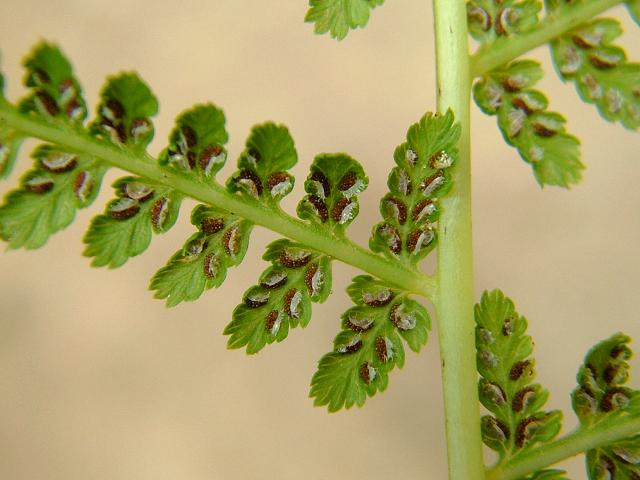
Botanical Name: Athyrium niponicum 'Pictum'
Common Name: Japanese painted fern
Family: Athyriaceae
Distribution/Origin: garden origin
Leaf: delicate fronds, cream and metallic variegation, bipinnately compound, oblong to lanceolate in shape, decurrent bases, pinnately lobed, deciduous
Bud:
Flower:
Fruit/Seed: dense brown clusters of sori, herringbone pattern
Stem/Bark: purple rachis
Size: 1-1.5’ height, 1-2’ spread
Habit: arching, spreading, upright
Form: vase
Soil conditions: humus rich, well drained
Moisture: low-medium
Sun: deep shade, filtered shade
Exposure: tolerates rabbits, heavy shade
Landscape use: accent plant, alpine garden, container planting, ground cover, group or mass planting, specimen plant, summer interest, woodland garden
Notes: can form dense colonies in optimal growing conditions
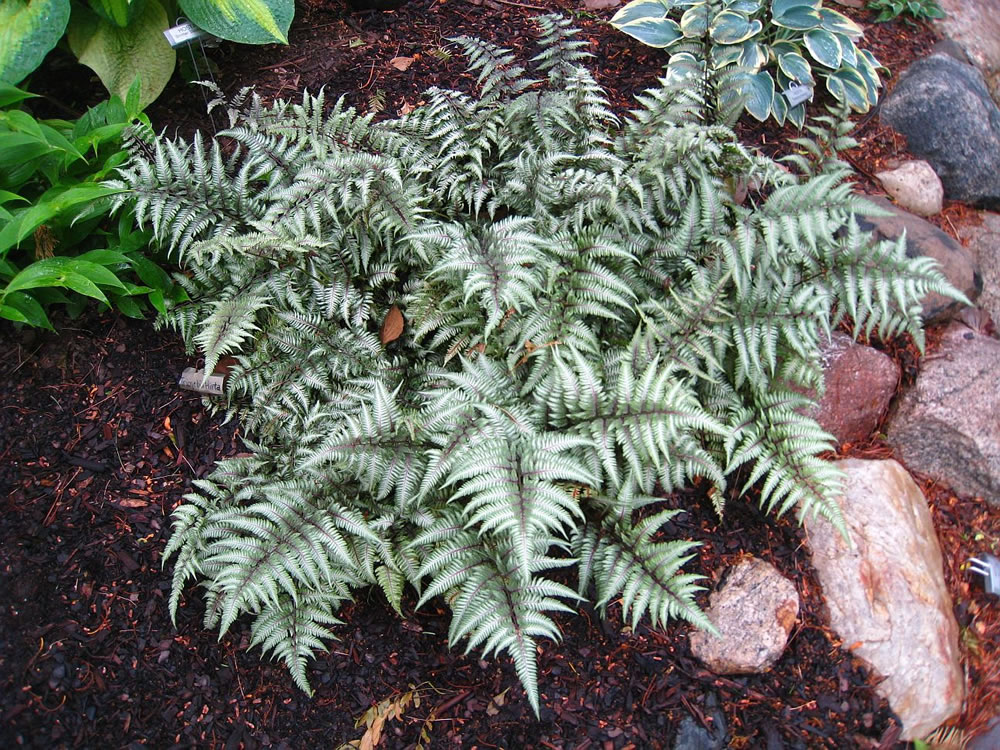



Botanical Name: Blechnum spicant
Common Name: deer fern
Family: Blechnaceae
Distribution/Origin: B.C, Europe, U.S
Leaf: linear, lustrous surfaces, bipinnately compound, entire margins, basal arrangement
Bud:
Flower:
Fruit/Seed: dark erect reproductive fronds
Stem/Bark: separate vegetative and reproductive fronds
Size: 1.5-2.5’ height, 1-2’ spread
Habit: arching, spreading, upright
Form: mounded, vase
Soil conditions: humus rich, well drained
Moisture: moderate
Sun: deep shade, filtered shade, part sun
Exposure:
Landscape use: container planting, filler, group or mass planting, perennial border, small garden, waterside planting
Notes:
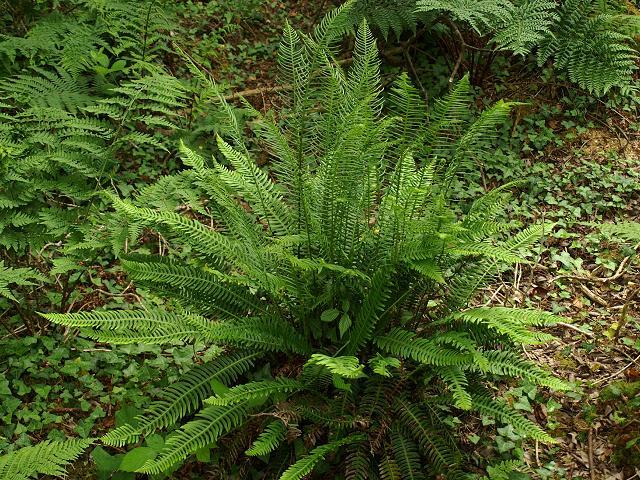
Notes:

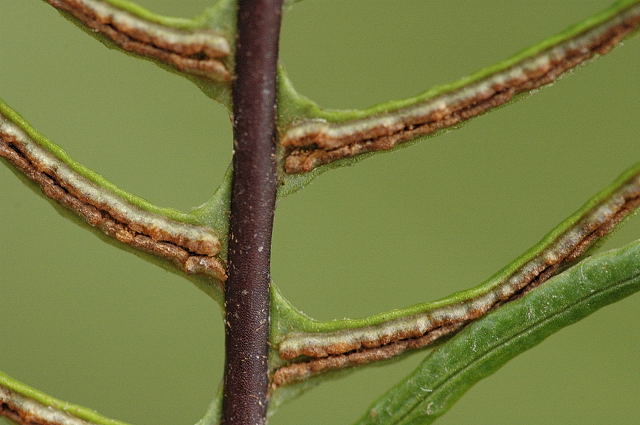
Botanical Name: Cyathea dealbata
Common Name: silver tree fern
Family: Cyatheaceae
Distribution/Origin: New Zealand
Leaf: silver undersides, 3 pinnate, large fronds
Bud:
Flower:
Fruit/Seed: small sphere shaped sori
Stem/Bark: golden brown trunk comprised of old growth, long persistent, peg like stipe bases, pale brown scales without marginal spines
Size: up to 32’ height, 20-30’ spread
Habit: horizontal
Form: erect, somewhat arching
Soil conditions: loose well drained, organically rich
Moisture: consistent moisture
Sun: filtered sunlight
Exposure: shelter from fierce winds and frosts
Landscape use: woodland garden, specimen
Notes: New Zealand’s national plant, in the wild used as a night time track marker when frond is placed silver side up




Botanical Name: Cyrtomium fortunei
Common Name: Japanese holly fern
Family: Dryopteridaceae
Distribution/Origin: Japan, China
Leaf: dull green, 12-26 leathery pinnae, lanceolate, evergreen
Bud:
Flower:
Fruit/Seed: spores are scattered on undersides of leaves
Stem/Bark:
Size: 1-2’ height, 1-2’ spread
Habit: horizontally arching, bushy
Form: stiff, upright
Soil conditions: humusy, well drained
Moisture: even moisture
Sun: full sun to partial shade
Exposure: sheltered from frosts
Landscape use: woodland garden, shaded areas of borders or rock gardens, naturalized areas, container gardening
Notes:



Botanical Name: Dryopteris erythrosora
Common Name: Japanese shield fern
Family: Dryopteridaceae
Distribution/Origin: eastern Asia
Leaf: evergreen, triangular bipinnate fronds, new growth is orange red to copper pink, matures to dark green
Bud:
Flower:
Fruit/Seed: dark red sori
Stem/Bark:
Size: 1.5-2.5’ height, 1.5-2.5’ spread
Habit: arching
Form: vase, clumping
Soil conditions: average, slightly acidic, humusy, organically rich
Moisture: medium, soils must not dry out
Sun: part shade to full shade
Exposure: tolerant of rabbit, heavy shade, shelter from heavy winds
Landscape use: moist woodland, shade gardens, massed in woodland area, ground cover
Notes: specific epithet is in reference to the striking red sori

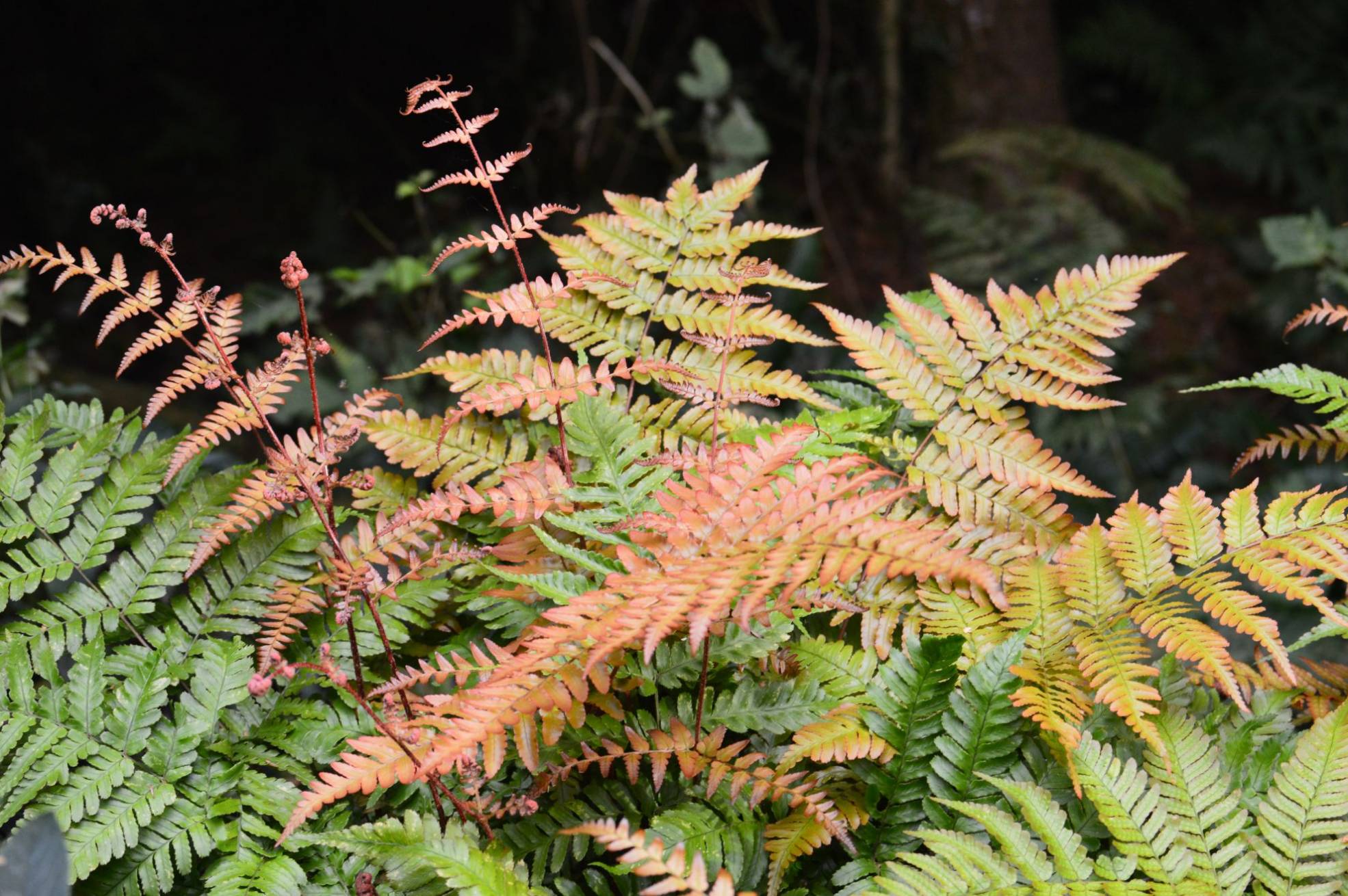


Botanical Name: Matteuccia struthiopteris
Common Name: ostrich fern
Family: Onocleaceae
Distribution/Origin: Europe, eastern Asia, eastern North America
Leaf: deciduous, finely dissected, medium green, vegetative sterile fronds, feathery appearance
Bud:
Flower:
Fruit/Seed: inner erect spike-like, dark brown fertile fronds, remain brown year round
Stem/Bark:
Size: 3-6’ height, 5-8’ spread
Habit: arching
Form: clumping, upright
Soil conditions: rich soils
Moisture: medium to wet, consistent
Sun: part shade to full shade
Exposure: tolerant of rabbits, heavy shade, erosion, clay soils, wet soils
Landscape use: naturalized area, rain garden, shaded areas
Notes: emerging fronds are often gathered as a culinary treat “fiddleheads” - and are magically delicious!
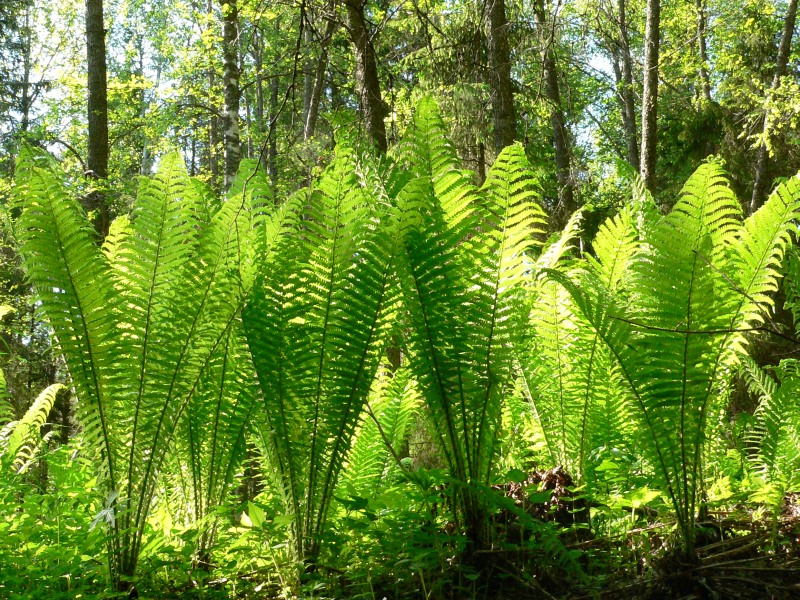


Botanical Name: Onoclea sensibilis
Common Name: sensitive fern
Family: Onocleaceae
Distribution/Origin: eastern Asia, eastern North America
Leaf: long stalked, deeply pinnatifid, bright green leathery textured, triangular leaflets with netted veins
Bud:
Flower:
Fruit/Seed: short, erect woody-like fertile fronds, bead like segments
Stem/Bark:
Size: 3-4’ height, 3-4’ spread
Habit: arching, erect
Form: clumping, irregular mounds
Soil conditions: organically rich, well drained
Moisture: medium to wet, consistent
Sun: full to partial shade
Sun: full to partial shade
Exposure: sensitive to frost, wind, well intentioned glances that are misinterpreted
Landscape use: wet woodland gardens, moist locations, water edges, shaded areas, naturalized plantings
Notes: named for observations made by the first settlers at how “sensitive” the fern was to any sort of external stimuli (mechanical damage, temperature fluctuations, etc)




Botanical Name: Osmunda regalis
Common Name: royal fern
Family: Osmundaceae
Distribution/Origin: North America
Leaf: large well separated pinnae, bright green, pinnately compound, glabrous leathery surfaces, serrulate margins
Bud:
Flower:
Fruit/Seed: spores are borne in brown tassel like fertile clusters at tips of fronds
Stem/Bark:
Size: 2-3’ height, 2-3’ spread
Habit: arching, stiffly upright
Form: vase, clumping
Soil conditions: acidic, humusy
Moisture: consistent
Sun: filtered sun
Exposure: can grow to 6’ if kept in constant moisture
Landscape use: accent plant, container, fall interest, mixed borders, specimen, waterside planting, woodland garden
Notes: fibers are commonly used in potting mixture for orchids

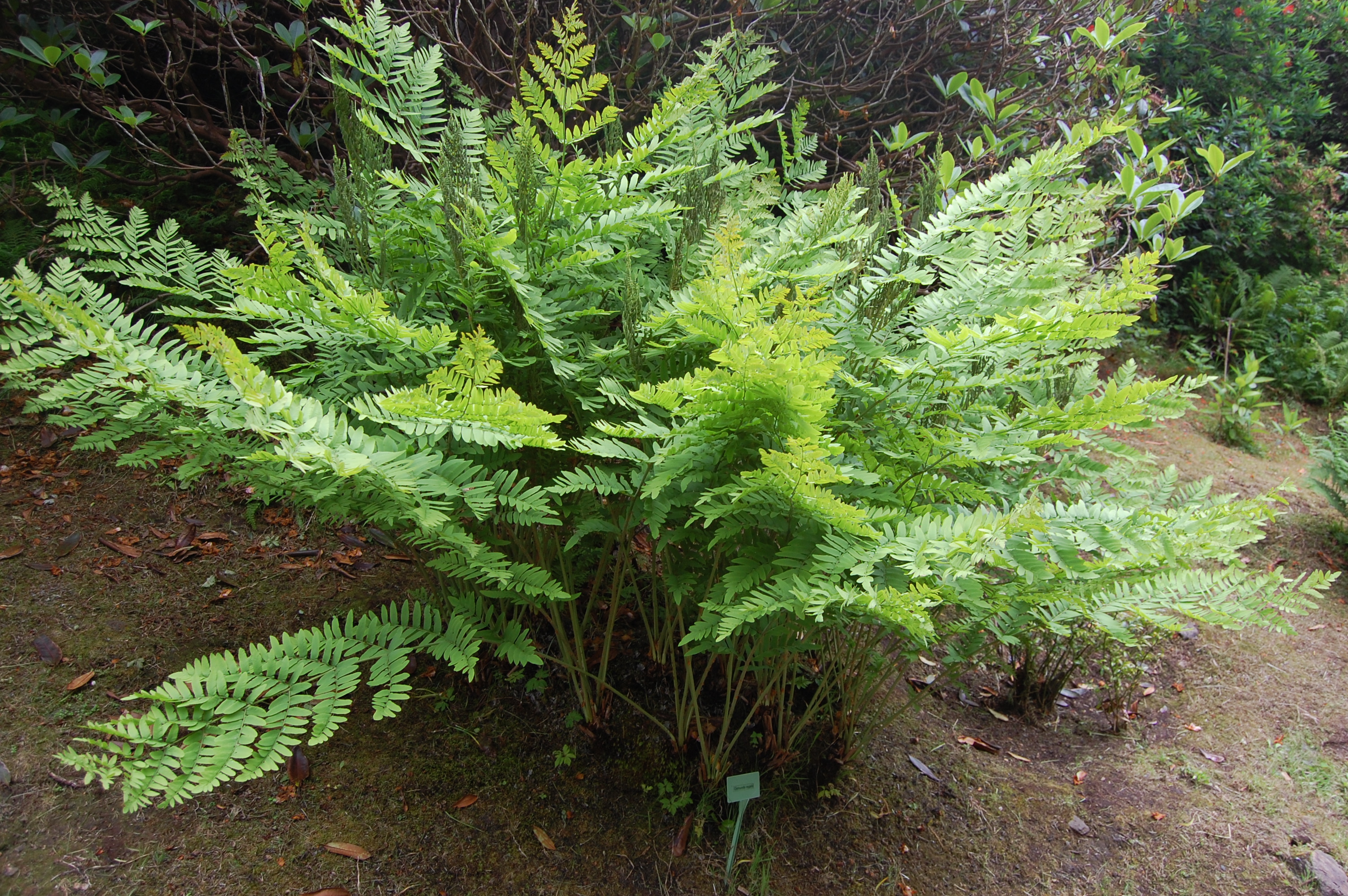


Botanical Name: Polystichum munitum
Common Name: western sword fern
Family: Dryopteridaceae
Distribution/Origin: western North America
Leaf: pinnately compound, delicate serrated margins, lanceolate, leathery lustrous surfaces
Bud:
Flower:
Fruit/Seed: yellow to orange sori, rounded, arranged in lines
Stem/Bark:
Size: 1-6’ height, 3-5’ spread
Habit: arching, radially spreading
Form: vase, clumping
Soil conditions: acidic, well drained, organically rich
Moisture: moderate
Sun: full to part shade
Exposure:
Landscape use: group/mass plantings, mixed shrub border, woodland areas
Notes: almost impossible to grow in the eastern part of North America




Botanical Name: Polystichum polyblepharum
Common Name: Japanese tassel fern
Family: Dryopteridaceae
Distribution/Origin: Asia
Leaf: pinnately compound, dark green, leathery lustrous surfaces, prickly texture, oblong to ovate in shape, divided
Bud:
Flower:
Fruit/Seed: brown circular sori
Stem/Bark:
Size: 1.5-2.5’ height, 1-2’ spread
Habit: arching
Form: vase
Soil conditions: acidic, humus rich, well drained
Moisture: consistent
Sun: deep to filtered shade
Exposure: protect from excessive winter wet by mulching crowns
Landscape use: alpine gardens, groundcover, group or mass plantings, mixed shrub border, rock gardens, summer interest, woodland gardens
Notes:

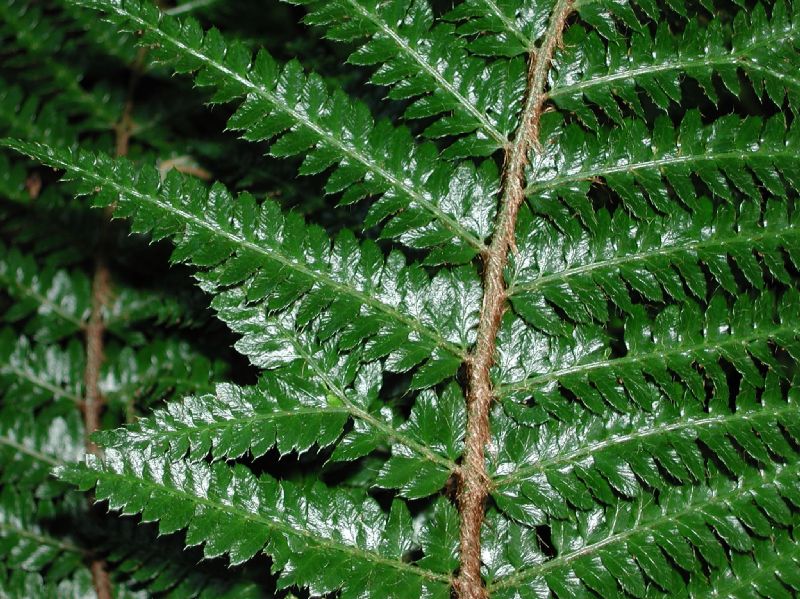


Botanical Name: Polystichum setiferum
Common Name: soft shield fern
Family: Dryopteridaceae
Distribution/Origin: Europe
Leaf: ovate pinnae, bipinnately compound, soft and flexible, lanceolate in shape, serrated margins
Bud:
Flower:
Fruit/Seed: circular fringed sori, yellow to orange
Stem/Bark: hairy rachis, brown
Size: 3-5’ height, 3-5’ spread
Habit: arching
Form: mounding, vase
Soil conditions: acidic, humus rich, well drained
Moisture: moderate
Sun: deep shade, filtered shade
Exposure: protect crowns from winter wet
Landscape use: container planting, ground cover, group or mass planting, perennial border, small garden space, summer interest, woodland gardens
Notes:


Botanical Name: Woodwardia fimbriata
Common Name: giant chain fern
Family: Blechnaceae
Distribution/Origin: western BC
Leaf: compound, soft flexible, ovate in shape, incised margins, opposite arrangement, evergreen
Bud:
Flower:
Fruit/Seed: chain like rows of sori
Stem/Bark:
Size: 4-8’ height, 4-6’ spread
Habit: arching
Form: vase
Soil conditions: well drained, organically rich
Moisture: average, even
Sun: filtered sun, partial shade
Exposure: deer resistant
Landscape use: waterside planting, woodland areas, naturalized landscapes
Notes: largest fern natural to North America 

No comments:
Post a Comment